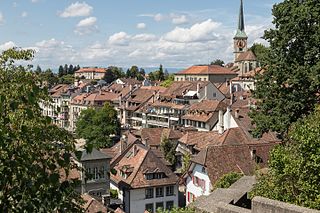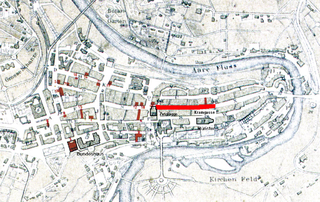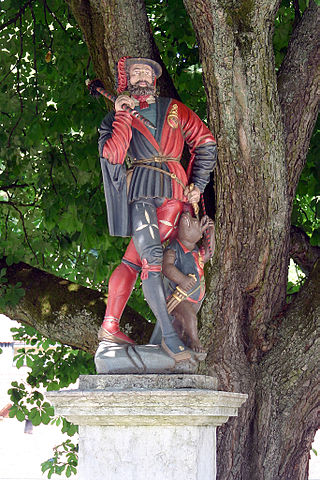
Bern, or Berne, is the de facto capital of Switzerland, referred to as the "federal city". With a population of about 133,000, Bern is the fifth-most populous city in Switzerland, behind Zürich, Geneva, Basel and Lausanne. The Bern agglomeration, which includes 36 municipalities, had a population of 406,900 in 2014. The metropolitan area had a population of 660,000 in 2000.

Burgdorf is the largest city in the Emmental in the canton of Bern in Switzerland. It was the capital of the district of the same name until 2010, when it became part of the new Emmental district.

The Old City is the medieval city center of Bern, Switzerland. Built on a narrow hill bordered on three sides by the river Aare, its compact layout has remained essentially unchanged since its construction during the twelfth to the fifteenth century. Despite a major fire in 1405, after which much of the city was rebuilt in sandstone, and substantial construction efforts in the eighteenth century, Bern's old city has retained its medieval character.

The Kindlifresserbrunnen is a painted stone fountain at the Kornhausplatz in Bern, Switzerland. It is one of the Old City of Bern's fountains from the 16th century.

The Kramgasse is one of the principal streets in the Old City of Bern, the medieval city centre of Bern, Switzerland. It was the center of urban life in Bern until the 19th century. Today, it is a popular shopping street. Its length, slight curve and long line of Baroque façades combine to produce Bern's most impressive streetscape.

The Gerechtigkeitsgasse is one of the principal streets in the Old City of Bern, the medieval city center of Bern, Switzerland. Together with its extension, the Kramgasse, it is the heart of the inner city. Hans Gieng's most famous fountain figure, the statue of Lady Justice on the Gerechtigkeitsbrunnen, commands the view of the street's gentle slopes and curves.

The Herrengasse is one of the streets in the Old City of Bern, the medieval city center of Bern, Switzerland. It was the southernmost street of the old Zähringerstadt of Bern and ended at the first city wall. Three buildings on the Herrengasse are listed on the Swiss inventory of heritage site of national significance and it is part of the UNESCO Cultural World Heritage Site that encompasses the Old City.

The Aarbergergasse is one of the streets in the Old City of Bern, the medieval city center of Bern, Switzerland. It was originally the most important of the five streets that were part of the Äussere Neustadt, which was the section outside the city walls. One fountain, the Ryfflibrunnen on the Aarbergergasse is listed on the Swiss inventory of heritage site of national significance and it is part of the UNESCO Cultural World Heritage Site that encompasses the Old City.

The Münstergasse is one of the streets in the Old City of Bern, the medieval city center of Bern, Switzerland. It is part of the Zähringerstadt which was built during the foundation of the old city in 1191. However, until 1967 it was parts of several other streets. It runs along the cathedral and it is part of the UNESCO Cultural World Heritage Site that encompasses the Old City.

The Spitalgasse is one of the streets in the Old City of Bern, the medieval city center of Bern, Switzerland. It is part of the Äussere Neustadt which was built during the third expansion from 1344 to 1346. The eastern end is at Waisenhausplatz and Bärenplatz while the western end is at Bahnhofplatz near the Church of the Holy Ghost. It is part of the UNESCO Cultural World Heritage Site that encompasses the Old City.

The Pfeiferbrunnen is a fountain near Spitalgasse 21 in Bern, Switzerland. It is one of the Old City of Bern's 16th-century fountains and is part of the list of Swiss heritage sites of national significance.

The Zähringerstadt is a historic section in the Old City of Bern in Bern, Switzerland.

The Bubenbergplatz is a plaza in the Old City of Bern, the medieval city center of Bern, Switzerland. It is part of the area outside the third city walls. It is located south-west of Bahnhofplatz and is part of the UNESCO Cultural World Heritage Site that encompasses the Old City.

The Bundesplatz is the Government Plaza in Bern, the de facto capital city of Switzerland. It is situated in the Old City of Bern, the medieval city center of Bern. It is part of the Innere Neustadt which was built during the second expansion in 1255 to 1260, though the plaza was not built until much later. It is located in front of the Bundeshaus, the Swiss Parliament Building, and it is part of the UNESCO Cultural World Heritage Site that encompasses the Old City.

The Kornhausplatz is a plaza in the Old City of Bern, the medieval city center of Bern, Switzerland. It is on the edge of the Zähringerstadt which was built during the founding of the city in 1191, though the plaza wasn't built until later. It is located near the Kornhausbrücke and the Zytglogge clock tower. It is part of the UNESCO Cultural World Heritage Site that encompasses the Old City.

The Läuferbrunnen is a fountain on Läuferplatz in the Old City of Bern, Switzerland. It is a Swiss Cultural Property of National Significance and is part of the UNESCO World Heritage Site of the Old City of Bern.

The Mosesbrunnen is a fountain on Münsterplatz in the Old City of Bern, Switzerland. It is a Swiss Cultural Property of National Significance and is part of the UNESCO World Heritage Site of the Old City of Bern.

The Simsonbrunnen or Samson fountain is a fountain on the Kramgasse in the Old City of Bern, Switzerland. It is a Swiss Cultural Property of National Significance and is part of the UNESCO World Heritage Site of the Old City of Bern.
The Zähringerbrunnen is a fountain on Kramgasse in the Old City of Bern, Switzerland. It is a Swiss Cultural Property of National Significance and is part of the UNESCO World Heritage Site of the Old City of Bern.

The Anna-Seiler-Brunnen is a fountain on Marktgasse in the Old City of Bern, Switzerland. It is a Swiss Cultural Property of National Significance and is part of the UNESCO World Heritage Site of the Old City of Bern.



















